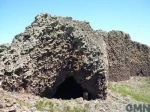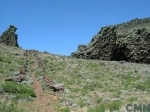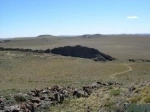Fell Cave, Pali Aike National Park. Punta Arenas - CHILE
The first inhabitants of the southern tip of Chile entered from the north and inland to the southern Patagonia region about 11,000 years ago, when the last glacial ice had retreated to the Andean peaks, giving way to more temperate weather. The evidence of these first groups of hunter-gatherers, grouped here under the name Cultural Period I or "Paleoindian" have been found in the area of Pali Aike volcanic esteparia, whose remains are a measure of cultural connection with several findings in other sectors of America (eg Ecuador).
One of its sites Fell Cave, a rock shelter located on the north arm stay on the River Chico or Ciake, overlooking a narrow but fertile valley that cuts the arid steppe landscape, near the border with Argentina. This site was a camp used by the newspaper men in those times still prevailed when the cold and the great animals now extinct, which it became a basic reference for understanding the Paleoindian Period.
Thus, in the aftermath of the last glacial period, an influx of hunters found in the cave Fell covered the southern tip of Chile and Argentina through several stops very homogeneous, survived until the dissolution of the Paleoindian features. One of the artifacts that symbolize their presence is the tip of projectile called "isinglass" because the base that penetrates the dart has that. These points were used extensively here, since even the repair again after being used and, judging by its location in the kitchen where he got the horse American prisoners, were used to despresar Pleistocene fauna.
At the bottom of this shelter Paleoindian remains, sealed by ash during a volcanic eruption regional, have been dated between 9000 and 8000 years BC Litos well up here in the form of polished disks are likely to be used in certain ceremonies, but the artifacts were the most common tips mentioned "isinglass" along with other tools such as stone dedicated to the work of fur or leather, including fine and retouch hallmarks used in harvesting or processing of lithic tools.
With these instruments could sustain animals as diverse as Milodon (Mylodon listai), the American horse (Parahipparion saldasi), guanaco, fox, cougar, birds, rodents, in addition to the collection of ostrich eggs. Ie, near-extinct wildlife species exploited modern, some little food and no proceeds of collection of the coastline, despite their relative proximity. Fell in occupation after this stage has been dated to more than 7000 years BC, when the classic Paleoindian features have disappeared, although some tools such as scrapers leather persist in the sequence.
From this analysis, note that terrestrial hunters developed food practices that pooled resources, integrating the sea in the area of their household chores. Thus, from step five of the remaining periods detected in Fell, during which the climate was more benign, the projectile points are dwarfed to adapt to using the bow and arrow to hunt especially guanacos, rhea, is incorporated boleadoras to catch birds, and increased consumption of shellfish harvested on the coast, it became known historically as ethnicity or Aonikenk Tehuelche who occupied the southern Patagonian river from Santa Cruz (Argentina) to the north and the Strait of Magellan in the south, at least until the nineteenth century when it began its extinction due to contact with the white man.




